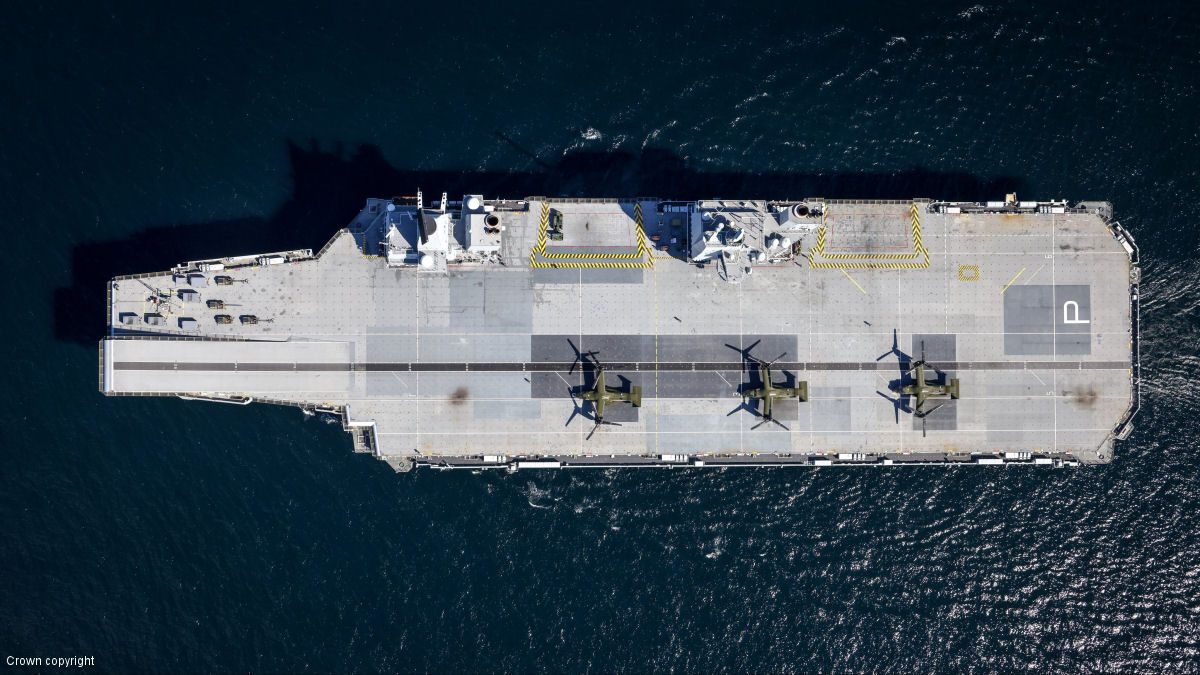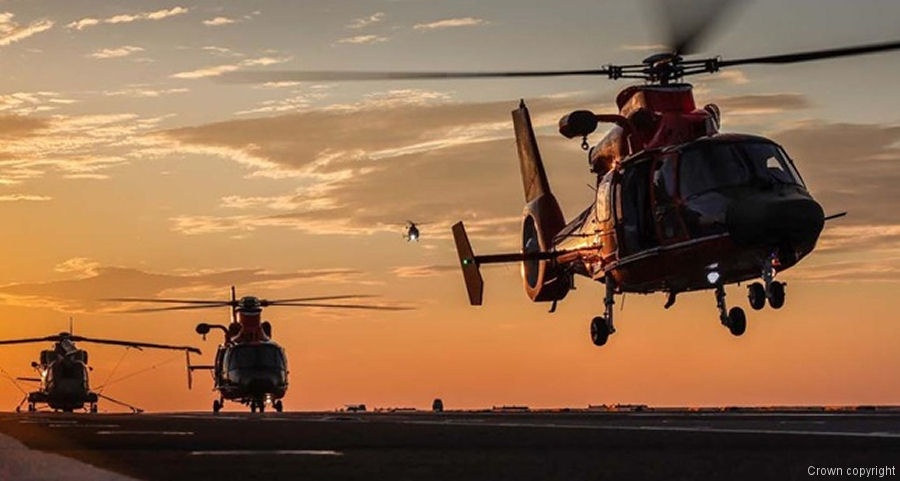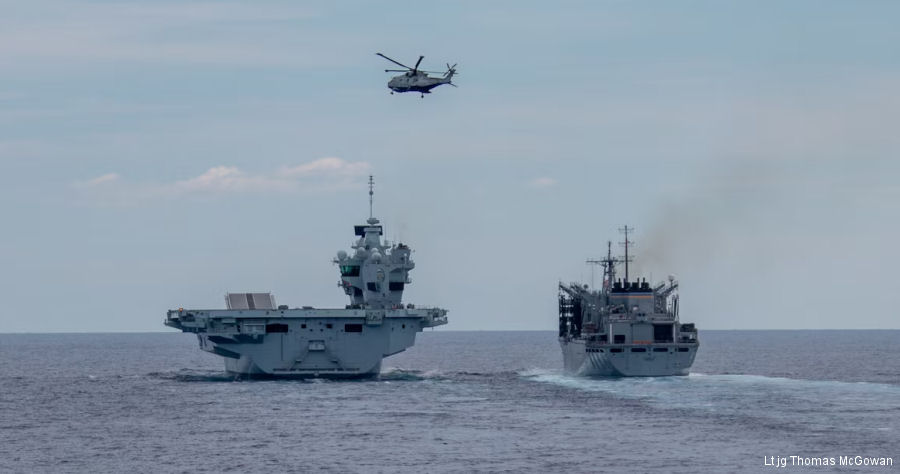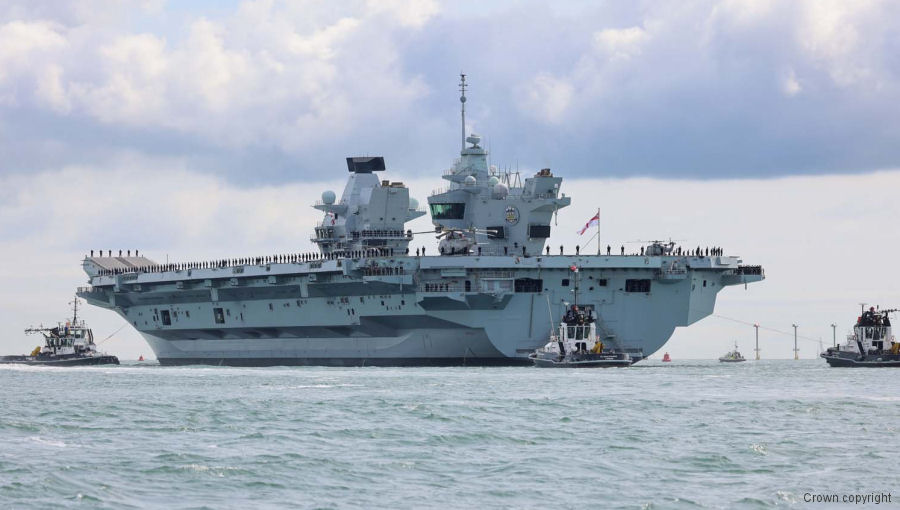
US Navy, October 22, 2023 - NORFOLK, Va. - The United Kingdom’s largest aircraft carrier, HMS Prince of Wales (R09), will make Naval Station Norfolk its temporary homeport this fall beginning Sept. 30 as it pushes the boundaries of Naval Aviation with F-35 Lightning advancement and drone launches off the East Coast over the next few months.
HMS Prince of Wales left for deployment in early September with a goal to further develop how the Royal Navy utilizes Carrier Strike Groups. After a visit to Mayport, Florida, the warship will be pushing the limits of their carrier, operating drones, strike fighters, tilt-rotors and helicopters from both the U.S. Navy and the U.S. Marine Corps.
Over the next few months the warship will specifically be pushing the boundaries of carrier landings for the U.K.’s fifth-generation jets, the F-35 Lightning stealth fighter.
Allowing the jets to land on the carrier faster and while carrying heavier loads (i.e. more fuel and weapons) will allow HMS Prince of Wales to launch more strike missions, faster.
The carrier will also practice launching and landing the F-35 in heavy sea states to demonstrate their ability to operate in harsh environments.
These sea states are why the HMS Prince of Wales is operating off the East Coast, to capitalize on the heavy seas that come with hurricane season in the United States.
Part of HMS Prince of Wales’ deployment will include multiple port calls to Naval Station Norfolk this fall, where they will be hosted by Carrier Strike Group-10 and the Nimitiz-class aircraft carrier USS George H.W. Bush (CVN 77).
Sailors aboard HMS Prince of Wales will be able to tour Naval Station Norfolk and visit surrounding areas in the coming months.

USCG MH-65 Dolphins landing on HMS Prince of Wales
Royal Navy - A Royal Navy pilot landing on a Royal Navy aircraft carrier.
Nothing unusual about that…
Except, Lieutenant Commander Bob Fleming was at the controls of an armed US Coast Guard MH-65E Dolphin helicopter used for intercepting drug smugglers.
The Fleet Air Arm officer is on exchange with the USCG’s Helicopter Interdiction Squadron (HITRON) and had the opportunity to land on HMS Prince of Wales as the carrier continues her mission off the east coast of the United States.
Lt Cdr Fleming is the first Royal Navy exchange pilot at HITRON and has been with the specialist squadron for 18 months carrying out operations from the Coast Guard’s cutters, tracking and stopping go-fasts carrying illegal cargo.
“HMS Prince of Wales invited HITRON aboard and we jumped on the opportunity for USCG pilots to experience landing on a UK carrier,” said Lt Cdr Fleming.
“It is something very rare for the USCG. Everyone enjoyed it immensely and we got some great photos.”
Lt Cdr Fleming has been deployed on counter drug trafficking operations in the East Pacific and Caribbean and has previously piloted Wildcat helicopters with the RN. He is a qualified instructor in the Wildcat Maritime Force who’s worked with 825 and 815 Naval Air Squadrons.
815 NAS have a close relationship with HITRON, regularly training together and sharing tactics and information on interception operations.
Prior to deploying on counter-narcotics operations, Wildcat crews come to the HITRON’s base in Jacksonville, Florida, to carry out training with the teams there and go up against the 900 horsepower tactical training boats, which play the role of the smugglers in practice scenarios.
The Wildcat helicopter and crew currently deployed with HMS Dauntless on the destroyer’s Caribbean patrol headed there in June and August, keeping themselves razor sharp for operations.
That paid dividends as the helicopter flight – known as Inferno 4 – scored operational success alongside a USCG team and Royal Marines after £140m of cocaine was seized from a go-fast in the Caribbean Sea.
Back on carrier business, Lt Fleming landed on HMS Prince of Wales as the ship began an autumn of trials pushing the boundaries of 21st century carrier operations off the east coast of the United States.
The carrier will be used for F-35 Lightning operations for the first stage of three trial periods involving crewed and uncrewed aircraft.
The three HITRON helicopters aren’t the only American aircraft to land on Prince of Wales this week.
The flight deck has been abuzz with activity – the unique tiltrotor Osprey MV-22s (from the 2nd Marine Aircraft Wing), Super Stallions, UH1 Super Hueys and AH-1Z Vipers have all appeared at different times this week ahead of the ship’s ten-day stop in Norfolk to load on all the related kit and equipment for the upcoming F-35 testing programme.
As HMS Prince of Wales continues her US mission, sister ship HMS Queen Elizabeth operates in northern European waters, operating with Joint Expeditionary Force and NATO allies at the heart of the UK Carrier Strike Group.

HMS Prince of Wales (R09) in underway replenishment with USNS Supply (T-AOE-6) off the East Coast
Royal Navy - On September 1st, Britain’s biggest warship sailed for her autumn deployment – her longest yet, pushing the limits of aircraft carrier operations with drones, fifth-generation stealth fighters, tilt-rotors and helicopters.
HMS Prince of Wales departs Portsmouth for the Eastern Seaboard of the USA to revolutionise the way the Royal Navy operates Carrier Strike Groups.
By the time she returns home shortly before Christmas, the ship will have:
• operated advanced drone technologies, demonstrating the delivery of vital supplies without the need to use helicopters;
• landed and launched F-35 Lightning stealth fighters in more ways, more quickly and in the harshest of sea conditions to increase the strike carrier’s firepower;
• and increased the range and conditions in which the US Marine Corps’ impressive MV-22 Osprey tilt rotor aircraft can operate.
Once in the Channel the ship’s company will conduct trials with UK-firm W Autonomous Systems to assess the feasibility of drones delivering supplies to Royal Navy vessels at sea – initially flying in up to 100kg of stores.
Both the Royal Navy and its supporting flotilla from the Royal Fleet Auxiliary are experimenting with drone technology – saving launching large, expensive naval helicopters to perform the missions.
“We are all excited for the longest deployment of HMS Prince of Wales,” said her Commanding Officer Captain Richard Hewitt.
“Being the first to operate with this level of drones will be a huge achievement and keep us on the front foot as we prepare for the next major Carrier Strike Group deployment in 2025.”
Once in the USA, the ship will embark F-35B stealth fighters for the final phase of pushing the boundaries of the UK’s fifth-generation jets’ operating limits from the carrier.
The F-35 has undergone extensive trials and assessment both in the US and UK operating from the flight decks of both Queen Elizabeth-class carriers and has deployed operationally.
But five years after the Lightning jets made their debut on a Royal Navy aircraft carrier, there’s still more to learn about the state-of-the-art fighter – and more to be exploited.
Pushing the boundaries will see more advanced take-off and landing techniques tested, allowing the F-35s to return to the carrier faster and heavier (i.e with more fuel and weapons aboard) which cuts the time between sorties, allowing the ship to launch more strike missions, faster.
HMS Prince of Wales will also be looking to launch and land the Lightning jets in the heaviest sea states, proving that they can operate the jets in the harshest environments.
“My team are really excited to tackle the final phase of testing which will expand the F-35’s awesome capabilities even more – and to be the first to land and launch new types of drones on our deck. The deck team are ready and raring to go,” said Commander Martin Russell, in charge of HMS Prince of Wales’ air group and flight deck operations.
Once the work with the F-35s is complete, focus will shift again to the next-generation of Short Take-Off and Landing drones currently under development.
The Mojave drone can carry a 1,500lb payload of missiles, rockets or bombs and has been specifically designed to land and take-off from short runways, or flight decks.
Trials are lined up to see whether the Mojave can land on the 901ft-long deck of the Prince of Wales.
The carrier’s stint Stateside will conclude by expanding the US Marine Corps’ unique tilt-rotor MV-22 Ospreys operating limits.
The Ospreys are used to transport troops and kit into battle. Expanding the ship’s operating limits for all of these aircraft over the deployment will allow even greater capacity for joint operations in the future, culminating in HMS Prince of Wales’ global deployment in 2025.
HMS Prince of Wales left for deployment in early September with a goal to further develop how the Royal Navy utilizes Carrier Strike Groups. After a visit to Mayport, Florida, the warship will be pushing the limits of their carrier, operating drones, strike fighters, tilt-rotors and helicopters from both the U.S. Navy and the U.S. Marine Corps.
Over the next few months the warship will specifically be pushing the boundaries of carrier landings for the U.K.’s fifth-generation jets, the F-35 Lightning stealth fighter.
Allowing the jets to land on the carrier faster and while carrying heavier loads (i.e. more fuel and weapons) will allow HMS Prince of Wales to launch more strike missions, faster.
The carrier will also practice launching and landing the F-35 in heavy sea states to demonstrate their ability to operate in harsh environments.
These sea states are why the HMS Prince of Wales is operating off the East Coast, to capitalize on the heavy seas that come with hurricane season in the United States.
Part of HMS Prince of Wales’ deployment will include multiple port calls to Naval Station Norfolk this fall, where they will be hosted by Carrier Strike Group-10 and the Nimitiz-class aircraft carrier USS George H.W. Bush (CVN 77).
Sailors aboard HMS Prince of Wales will be able to tour Naval Station Norfolk and visit surrounding areas in the coming months.
Procession of helicopters land on HMS Prince of Wales during United States mission

USCG MH-65 Dolphins landing on HMS Prince of Wales
Royal Navy - A Royal Navy pilot landing on a Royal Navy aircraft carrier.
Nothing unusual about that…
Except, Lieutenant Commander Bob Fleming was at the controls of an armed US Coast Guard MH-65E Dolphin helicopter used for intercepting drug smugglers.
The Fleet Air Arm officer is on exchange with the USCG’s Helicopter Interdiction Squadron (HITRON) and had the opportunity to land on HMS Prince of Wales as the carrier continues her mission off the east coast of the United States.
Lt Cdr Fleming is the first Royal Navy exchange pilot at HITRON and has been with the specialist squadron for 18 months carrying out operations from the Coast Guard’s cutters, tracking and stopping go-fasts carrying illegal cargo.
“HMS Prince of Wales invited HITRON aboard and we jumped on the opportunity for USCG pilots to experience landing on a UK carrier,” said Lt Cdr Fleming.
“It is something very rare for the USCG. Everyone enjoyed it immensely and we got some great photos.”
Lt Cdr Fleming has been deployed on counter drug trafficking operations in the East Pacific and Caribbean and has previously piloted Wildcat helicopters with the RN. He is a qualified instructor in the Wildcat Maritime Force who’s worked with 825 and 815 Naval Air Squadrons.
815 NAS have a close relationship with HITRON, regularly training together and sharing tactics and information on interception operations.
Prior to deploying on counter-narcotics operations, Wildcat crews come to the HITRON’s base in Jacksonville, Florida, to carry out training with the teams there and go up against the 900 horsepower tactical training boats, which play the role of the smugglers in practice scenarios.
The Wildcat helicopter and crew currently deployed with HMS Dauntless on the destroyer’s Caribbean patrol headed there in June and August, keeping themselves razor sharp for operations.
That paid dividends as the helicopter flight – known as Inferno 4 – scored operational success alongside a USCG team and Royal Marines after £140m of cocaine was seized from a go-fast in the Caribbean Sea.
Back on carrier business, Lt Fleming landed on HMS Prince of Wales as the ship began an autumn of trials pushing the boundaries of 21st century carrier operations off the east coast of the United States.
The carrier will be used for F-35 Lightning operations for the first stage of three trial periods involving crewed and uncrewed aircraft.
The three HITRON helicopters aren’t the only American aircraft to land on Prince of Wales this week.
The flight deck has been abuzz with activity – the unique tiltrotor Osprey MV-22s (from the 2nd Marine Aircraft Wing), Super Stallions, UH1 Super Hueys and AH-1Z Vipers have all appeared at different times this week ahead of the ship’s ten-day stop in Norfolk to load on all the related kit and equipment for the upcoming F-35 testing programme.
As HMS Prince of Wales continues her US mission, sister ship HMS Queen Elizabeth operates in northern European waters, operating with Joint Expeditionary Force and NATO allies at the heart of the UK Carrier Strike Group.
HMS Prince of Wales heads to USA to shape future of naval aviation

HMS Prince of Wales (R09) in underway replenishment with USNS Supply (T-AOE-6) off the East Coast
Royal Navy - On September 1st, Britain’s biggest warship sailed for her autumn deployment – her longest yet, pushing the limits of aircraft carrier operations with drones, fifth-generation stealth fighters, tilt-rotors and helicopters.
HMS Prince of Wales departs Portsmouth for the Eastern Seaboard of the USA to revolutionise the way the Royal Navy operates Carrier Strike Groups.
By the time she returns home shortly before Christmas, the ship will have:
• operated advanced drone technologies, demonstrating the delivery of vital supplies without the need to use helicopters;
• landed and launched F-35 Lightning stealth fighters in more ways, more quickly and in the harshest of sea conditions to increase the strike carrier’s firepower;
• and increased the range and conditions in which the US Marine Corps’ impressive MV-22 Osprey tilt rotor aircraft can operate.
Once in the Channel the ship’s company will conduct trials with UK-firm W Autonomous Systems to assess the feasibility of drones delivering supplies to Royal Navy vessels at sea – initially flying in up to 100kg of stores.
Both the Royal Navy and its supporting flotilla from the Royal Fleet Auxiliary are experimenting with drone technology – saving launching large, expensive naval helicopters to perform the missions.
“We are all excited for the longest deployment of HMS Prince of Wales,” said her Commanding Officer Captain Richard Hewitt.
“Being the first to operate with this level of drones will be a huge achievement and keep us on the front foot as we prepare for the next major Carrier Strike Group deployment in 2025.”
Once in the USA, the ship will embark F-35B stealth fighters for the final phase of pushing the boundaries of the UK’s fifth-generation jets’ operating limits from the carrier.
The F-35 has undergone extensive trials and assessment both in the US and UK operating from the flight decks of both Queen Elizabeth-class carriers and has deployed operationally.
But five years after the Lightning jets made their debut on a Royal Navy aircraft carrier, there’s still more to learn about the state-of-the-art fighter – and more to be exploited.
Pushing the boundaries will see more advanced take-off and landing techniques tested, allowing the F-35s to return to the carrier faster and heavier (i.e with more fuel and weapons aboard) which cuts the time between sorties, allowing the ship to launch more strike missions, faster.
HMS Prince of Wales will also be looking to launch and land the Lightning jets in the heaviest sea states, proving that they can operate the jets in the harshest environments.
“My team are really excited to tackle the final phase of testing which will expand the F-35’s awesome capabilities even more – and to be the first to land and launch new types of drones on our deck. The deck team are ready and raring to go,” said Commander Martin Russell, in charge of HMS Prince of Wales’ air group and flight deck operations.
Once the work with the F-35s is complete, focus will shift again to the next-generation of Short Take-Off and Landing drones currently under development.
The Mojave drone can carry a 1,500lb payload of missiles, rockets or bombs and has been specifically designed to land and take-off from short runways, or flight decks.
Trials are lined up to see whether the Mojave can land on the 901ft-long deck of the Prince of Wales.
The carrier’s stint Stateside will conclude by expanding the US Marine Corps’ unique tilt-rotor MV-22 Ospreys operating limits.
The Ospreys are used to transport troops and kit into battle. Expanding the ship’s operating limits for all of these aircraft over the deployment will allow even greater capacity for joint operations in the future, culminating in HMS Prince of Wales’ global deployment in 2025.

HMS Prince of Wales departing Britain
See also |
HMX-1
MV-22 in
HH/MH-65 Dolphin in




